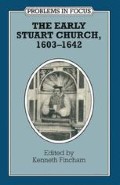Abstract
Recent scholarship has tended to contrast the acumen and flexibility of James I with the ineptitude and rigidity of his son Charles I, whose shortcomings are regarded as perhaps the most obvious cause of the Civil War.1 This interpretation has been most marked in religious history, with Charles’s government held responsible for both the final destruction of the Calvinist dominance of the English Church and the triumph of Arminianism, which created tensions powerful enough to destabilise politics and lay the ground for war. In some accounts, the villain of the piece is not Charles I but William Laud, whose doctrinaire policies and irascible rule proved disastrous for himself and the Stuart monarchy.2
Preview
Unable to display preview. Download preview PDF.
Bibliography
James’s kingcraft is best approached through J. Wormald, ‘James VI and I: two kings or one?’ History, 68 (1983); see also M. Lee, Great Britain’s Solomon: James VI and I in his three kingdoms (Urbana, III., 1990).
For important work on his attitude to puritans, see F. Shriver, ‘Hampton Court Revisited: James I and the Puritans’ JEH, 33 (1982) and B. W. Quintrell, ‘The Royal Hunt and the Puritans 1604–5’, ibid., 31 (1980); towards Rome, see W. B. Patterson’s two articles, ‘King James I’s call for an Ecumenical Council’ in Studies in Church History, 7, eds G.J. Cuming and D. Baker (Cambridge, 1971) and ‘King James I and the Protestant Cause in the Crisis of 1618–22’ Studies in Church History, 18, ed. S. Mews (Oxford, 1982). Studies of Jacobean court bishops have illuminated ecclesiastical politics during the reign. See S. B. Babbage, Puritanism and Richard Bancroft (1962), and P. A. Welsby’s Lancelot Andrewes (1958) and George Abbot (1962). For a recent attempt to rehabilitate Abbot, see K. Fincham, ‘Prelacy and Politics: Archbishop Abbot’s defence of Protestant Orthodoxy’ Historical Research, 61 (1988).
C. H. Mcllwain (ed.), The Political Works of James I (Cambridge, Mass., 1918), contains speeches as well as published writings; and for a good insight into both James’s role as mediator, and the range of issues dividing his leading churchmen, see N. Cranfield and K. Fincham (eds), John Howson’s answers to Archbishop Abbot’s accusations at his “trial” before James I... 1615’ in Camden Miscellany XXIX (Camden 4th series, 34, 1987).
There is less to recommend on Charles I, a result of royal reticence and the production in the nineteenth century of Laud’s Works, in seven volumes, which has distracted attention from his supreme governor. However, some important research has been published recently on the political and religious values of Charles and his court: K. Sharpe, ‘The image of virtue: the court and household of Charles I’ in D. Starkey (ed.), The English Court (Harlow, 1987); C. Russell, The Causes of the English Civil War (Oxford, 1990), ch. 8; R. M. Smuts, Court Culture and the Origins of a Royalist Tradition in Early Stuart England (Philadelphia, 1987); and C. Hibbard, Charles I and the Popish Plot (New Chapel, NC, 1983). Dr Sharpe has a major study of the Personal Rule forthcoming (1992) from Yale.
G. Albion, Charles I and the Court of Rome (1935) contains valuable accounts of Charles I’s conversations with successive papal agents; G. Donaldson, The Making of the Scottish Prayer Book of 1637 (Edinburgh, 1954) offers evidence of Charles’s directing hand: K. Sharpe has championed Charles I as the architect of religious policy in the 1630s, in his Politics and Ideas in Early Stuart England (1989), pp. 108-9, 123-8. Readers may draw their own conclusions by consulting one important source, the royal annotations on the annual reports on the Church between 1633 and 1640, printed in W. Laud, Works, ed. J. Bliss and W. Scott (7 vols, Oxford, 1847–60), reprinted 7 vols in 5, Olms, New York, 1977), vol. 5.
Editor information
Copyright information
© 1993 Kenneth Fincham and Peter Lake
About this chapter
Cite this chapter
Fincham, K., Lake, P. (1993). The Ecclesiastical Policies of James I and Charles I. In: Fincham, K. (eds) The Early Stuart Church, 1603–1642. Problems in Focus Series. Palgrave, London. https://doi.org/10.1007/978-1-349-22771-6_2
Download citation
DOI: https://doi.org/10.1007/978-1-349-22771-6_2
Publisher Name: Palgrave, London
Print ISBN: 978-0-333-51114-5
Online ISBN: 978-1-349-22771-6
eBook Packages: Palgrave Religion & Philosophy CollectionPhilosophy and Religion (R0)

